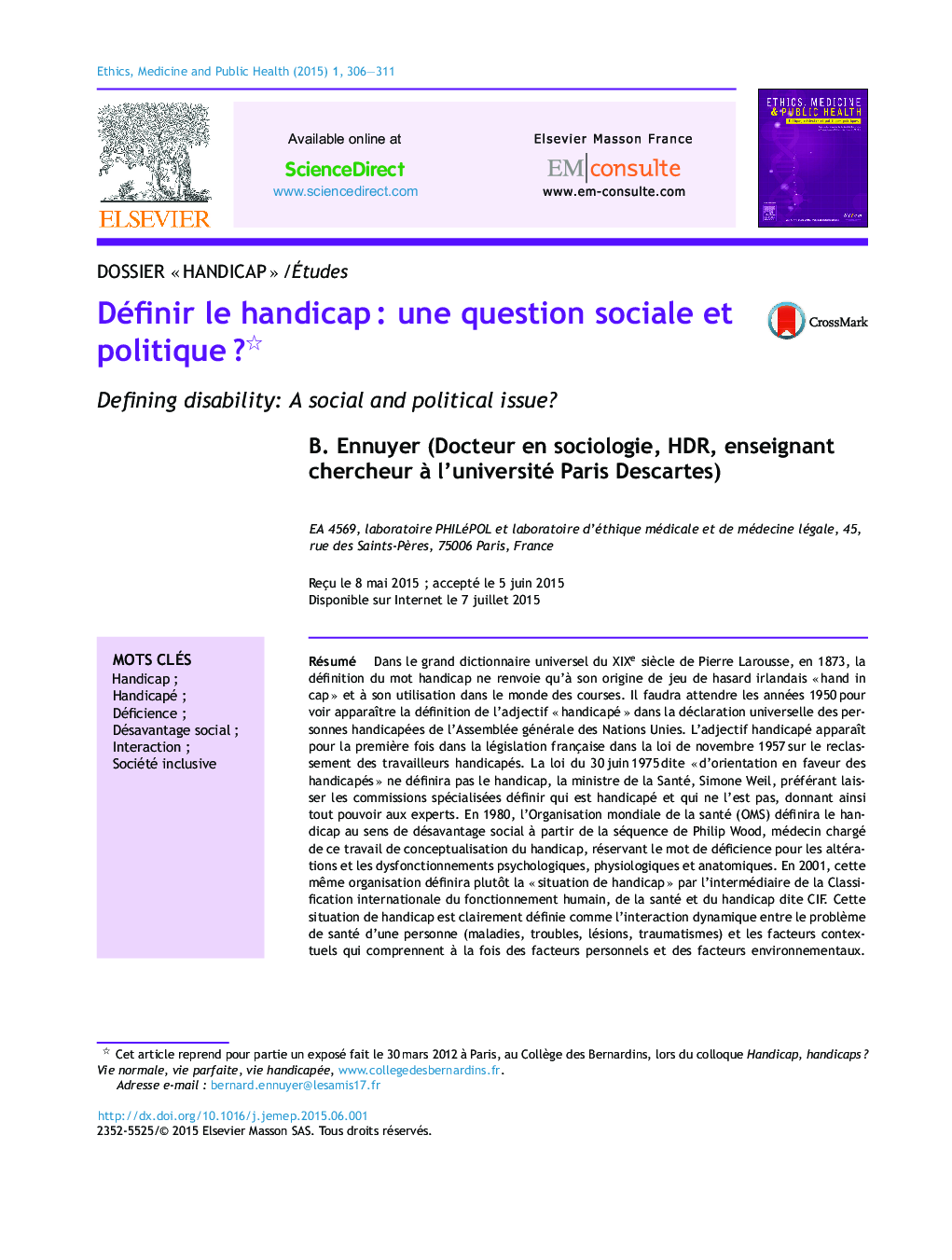| کد مقاله | کد نشریه | سال انتشار | مقاله انگلیسی | نسخه تمام متن |
|---|---|---|---|---|
| 1097737 | 952869 | 2015 | 6 صفحه PDF | دانلود رایگان |

RésuméDans le grand dictionnaire universel du XIXe siècle de Pierre Larousse, en 1873, la définition du mot handicap ne renvoie qu’à son origine de jeu de hasard irlandais « hand in cap » et à son utilisation dans le monde des courses. Il faudra attendre les années 1950 pour voir apparaître la définition de l’adjectif « handicapé » dans la déclaration universelle des personnes handicapées de l’Assemblée générale des Nations Unies. L’adjectif handicapé apparaît pour la première fois dans la législation française dans la loi de novembre 1957 sur le reclassement des travailleurs handicapés. La loi du 30 juin 1975 dite « d’orientation en faveur des handicapés » ne définira pas le handicap, la ministre de la Santé, Simone Weil, préférant laisser les commissions spécialisées définir qui est handicapé et qui ne l’est pas, donnant ainsi tout pouvoir aux experts. En 1980, l’Organisation mondiale de la santé (OMS) définira le handicap au sens de désavantage social à partir de la séquence de Philip Wood, médecin chargé de ce travail de conceptualisation du handicap, réservant le mot de déficience pour les altérations et les dysfonctionnements psychologiques, physiologiques et anatomiques. En 2001, cette même organisation définira plutôt la « situation de handicap » par l’intermédiaire de la Classification internationale du fonctionnement humain, de la santé et du handicap dite CIF. Cette situation de handicap est clairement définie comme l’interaction dynamique entre le problème de santé d’une personne (maladies, troubles, lésions, traumatismes) et les facteurs contextuels qui comprennent à la fois des facteurs personnels et des facteurs environnementaux. En France, c’est la loi de février 2005 « pour l’égalité des droits et des chances, la participation et la citoyenneté des personnes handicapées » qui donnera la première définition officielle du handicap, en s’appuyant en partie sur le travail conceptuel de la CIF. De ce parcours dans les différentes définitions du handicap, on peut en conclure qu’une définition consensuelle autour du mot handicap est quasi impossible comme le dit l’anthropologue Henri-Jacques Stiker, tant sont grands les enjeux politiques, économiques et surtout corporatistes… Alors peut-on faire advenir une société « inclusive » où chacun trouverait sa place en fonction de ses capacités et de ses incapacités et où la définition même du mot handicap deviendrait sans objet ?
SummaryIn Pierre Larousse's impressive 19th century dictionary, in 1873, the definition of handicap only refers to its origin in the Irish game of chance “hand in cap” and to its use in horse-racing. It is only in the 1950s that the adjective “handicapped” appears in the United Nations Universal Declaration of handicapped people. The adjective handicapped appeared for the first time in the French legal system, in the law of November 1957, classifying handicapped workers. The 30th June 1975 law, called d’orientation en faveur des handicapés (orientation in favour of the handicapped) does not define handicap; the Minister of Health, Simone Weil, preferring to leave the definition of who is, and who is not, handicapped, to specialized commissions, thus giving the authority to experts. In 1980, the World Health Organisation (WHO) defined handicap in the sense of social disadvantage, based on the sequence given by Philip Wood, the doctor entrusted with the job of conceptualizing handicap, reserving the term deficiency for deterioration and psychological, physiological and anatomic malfunctioning. In 2001, this same organization defined rather the “handicap situation” using the international classification of human functioning, health and handicap, called ICF. Thus, handicap is clearly defined as the dynamic interaction between a person's health problems (illness, disorder, lesions, trauma) and contextual factors, including both personal and environmental. In France, the law of February 2005 pour l’égalité des droits et des chances, la participation et la citoyenneté des personnes handicapées (for equality of rights and opportunities, participation and citizenship of handicapped people) gave the first official definition of handicap, based on the conceptual work of the ICF. In this path, through the various definitions of handicap, we can conclude that a consensual definition of the word handicap is almost impossible, as pointed out by the anthropologist Henri-Jacques Stiker, so large are the political, economic and, above all, corporate stakes… So, can one make an “inclusive” society, where each finds his place as function of his capacities and his capabilities, and where the definition of the word handicap becomes unnecessary?
Journal: Ethics, Medicine and Public Health - Volume 1, Issue 3, July–September 2015, Pages 306–311